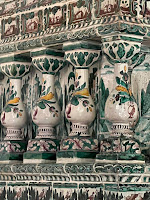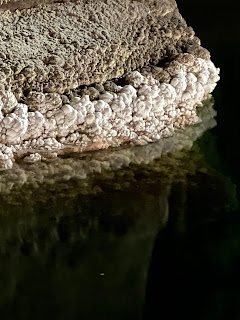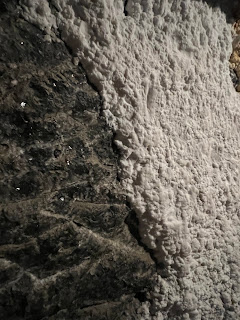The second half of our time in Kraków was spent exploring town and checking out the salt mines. We took an early flight from Vienna to Kraków and after dropping our bags at the hotel we headed over to St. Mary’s Basilica in time to see the opening of the Main Altar. Every day at 11:50am a nun opens the almost 600 year old altar. The church, consecrated in 1320, is absolutely stunning and sits in the middle of Main Square. The video of the opening is too large to upload but if we're Facebook friends, you can find it on July 18.
If you look closely on the left of the altar, you can see the nun in her habit. She is maybe 4' 10" and all of 70 pounds. Clearly not her first rodeo opening the altar as she did it with such precision and ease.
 |
As Kraków's favorite son and Poland's only Pope,
there are pictures and statues of St. John Paul II all over town |
 |
With all the wood in the church, it makes
sense there were so many fire extinguishers. |
 |
| Main Square |
How could we come to Poland and not have pierogies!
Normally, we like to do a hop-on/hop-off tour to get a good overview of a town but the reviews for the one in Kraków were really bad so I found a private tour on Get Your Guide in an electric cart (seems to be the way to go in Kraków as you see them everywhere). Our guide, Maciek (Mathew), was great and took us all over town and in particular pointed out the many many Jewish synagogues that once used to be very active but sadly today only one has regular weekly services. Prior to the Holocaust, there were approximately 70,000 Jews in Kraków…today there are approximately 150. We also saw several churches and learned about life prior to WWII along the way.
 |
| Basilica of St. Michael the Archangel |
 |
| Church of St. Catherine |
In the middle of the former ghetto is the Plac Bohaterów Getta (The Ghetto Heroes Square). There are 70 chairs and each chair represents 1,000 Jews that lived in Kraków prior to the Holocaust and the liquidatation of the ghetto on March 13, 1943.
Only because the Germans were afraid of their officers contracting tuberculosis and other diseases from the Jews living in such close quarters, they allowed one pharmacist to remain open and provide medication, Tadeusz Pankiewicz. Not only did he provide them medicaiton, he and his staff would smuggle in items and news from outside the ghetto.
Before the ghetto was established, there were 5,000 Poles living in the area but the Germans moved them out and walled in the area. In place of the 5,000 Poles, 16,000 Jews were placed. Each person had roughly 2 square meters (21.5 square feet) to live. This is a bit of the remaining wall that separated Jews from the rest of their city.
 |
Prior to the Jews being forced into the ghetto,
the brightly colored doors througout Kazimierz were shops. |
 |
| Vielle Synagogue (Old Synagogue) |
Helena Rubinstein grew up in Kazimierz of Kraków as the daughter of a shopkeeper. She later became an American businesswoman creating a cosmetic empire which made her one of the richest women in America.
 |
Memorial Stone of the Nissembaum Family Foundation
In rememberance of the 65,000 Jews
from Kraków killed in the Holocaust |
We saw these delicious looking pastries and had to pick up one to split for breakfast one morning. It was tasty but it did look better than it tasted.
Built in the 13th and 14th centuries, Wawel Royal Castle sits high above Kraków. You can tour the grounds for free but if you would like to see the gardens, private rooms, St. Catherine’s Cathedral and dragon statue, you have to buy tickets. They have about 5 different options for tickets depending on what you wanted to see…we picked the Castle I which included the Private Royal Apartments, Royal Gardens, the Porcelain Cabinet and the Art of the Orient. We opted for the audio guide and I must say it was perhaps the best audio guide we’ve ever had! The guide had GPS and gave excellent directions from the time you left the ticket office and had pictures of the item being described so you knew you were in the correct location.
 |
The Crucifixion
Meissen, 1744 |
While Wawel is a public institution, you cannot buy tickets to St. Catherine’s at the same time and have to go to a separate ticket office to get church tickets and audio guide. The audio guide for the church did have GPS but wasn’t as good though we are glad we had it. Photos could only be taken in a few parts of the church so we’ll just have to rely on our memories.
 |
| The perfect way to relax after touring the castle and church |
One of my clients lives in Warsaw and when I told him we were visiting Kraków, he said we had to go to
Wieliczka Salt Mine. We had been to salt mines in Kansas and I thought how different could they be but knew if my client said they were amazing, I knew they had to be (he has extremely high expectations which is why we get along so well ) so off we went. You can get to Wieliczka via Bolt/Uber, train or bus…we opted for Bolt just for the convenience. Upon research, I discovered there are about 800 steps down to the bottom of the mine which were slightly spiral and steep and I knew would not be good for LuLu. Like Vienna and much of Europe these days, Wieliczka has made accommodations for those with disabilities or elderly and has a special tour first thing and last thing each day which allows visitors to take the lift down and do a slightly condensed tour.
 |
| Heading down into the mine |
The miners called this salt cauliflower since it resembles cauliflower.
Prior to electricity being installed in 19th century, miners used head lamps and candles to provide lighting. As white reflects light, they painted the walls with a special mixture that not only reflected the light but was fire resistant.
With the exception of the timber, everything inside the mine is made from salt (including the floors we walked). Our condensed tour was two hours verses the three hours of the standard tour…based upon a few videos I saw before our visit, we only missed a few places but saw the highlights which included the Chapel of St. Kinga (they celebrate mass every Sunday in the chapel for up to 700). Legend has it that when Kinga (originally from Hungary) was pledged to her Polish husband she dropped her engagement ring into a salt mine in Hungary. When she arrived in Wieliczka, she ordered someone dig in a particle spot. What was found was the very diamond ring she dropped in the Hungarian mine. Since the 13th century, there has been salt in Wieliczka.
The chandeliers are made from salt…not glass
I wasn’t sure if the photos would do any justice so I shot a video in hopes it had better detail given the low lighting of the chapel.
As I mentioned, everything is made of salt including the floors. You can see in these pics how all the walking visitors do polishes the floors verses that around one of the statues that does not get any foot traffic.
Burgers and fries from the food trucks across form the hotel were on the menu after a long day of sightseeing one evening. All we wanted to do was grab and go to our room where it was cool. The burgers were AMAZING and HUGE! The fries were equally as good. Perfect way to end a day exploring Kraków.

Kraków has a good public transportation system and very affordable. We rode the system three of our four days and paid less than $20 total! Again, thanks to the Moovit app I mentioned in an earlier post, we could easily get around town. Like Vienna, it operates on an honor system and you have to purchase tickets then validate them once on the tram. We were never stopped to make sure our tickets were validated but if we had been and we did not have a validated ticket, the fines would have been very high.
I know this is going to come as a surprise but we stumbled upon another church! This one is St. Simon of Lipnica. The church is also referred to as the Bernadine Church as the order of Brownfrairs runs the church officially the Church of St. Bernadine of Siena of the Order of Friars Minor of Regular Observance.
Relics of St. Simon
During the pandemic, none of the friars contracted Covid. They attribute it to the the intercession of St. Simon of Lipnica.
St. Simon of Lipnica pray for us!
You see these stands all over town selling obwarzanek (aka Kraków pretzel). We noticed locals grabbing them as they were on their way to work and they make a great snack to have in your backpack in case you get a little peckish while exploring the city. The going rate is 3 zołty (zł) which is a roughly $0.75. During our visit, $1 equaled approximately 4 zł.


We had all the best intentions of going to mass on Sunday as we found a church whose website said they celebrated in English at 10:30. Unfortunately, mass didn't happen and according to Maciek (LuLu decided a man we met outside of church looked like a Matthew) sometimes the priest isn't available. Maciek was a local and regularly attends mass in English as he is working on his English. He was such a nice man and when we said we were from Charleston, he said "oh where the American Insurrection took place". Gotta love how people outside of the US are so familiar with our history...we were particularly impressed with his familiarity to Charleston! Maciek told us about St. Paul and Peter Church around the corner so we set out to explore it. The church was consecrated in 1635.





 |
St. Anthony of Padua seems to show up everywhere
we go...guess that's why we never seem to get lost. |
The Romanesque St. Andrew's Church sits next door and was erected in the second half of the 11th century. The sisters of The Poor Clares order took over the church in the 13th century and added a monastery following very strict monastic rules. The Poor Clares remain here today.
We enjoyed our time in Kraków but were glad to be heading back to Vienna as we still have much to see in the little bit of time we have left. If you fly into Vienna, you can take the CAT (City Airport Train) for about $16 and it drops you off in the city center in about 16 minutes. From Wien Mitte (city center station), you can easily get anywhere in town.








































































































































































No comments:
Post a Comment